Will 12 Step Rehab Work for Me?
The 12 step method is considered by many addiction experts to be the best help for long-term addiction recovery. However, it is not without controversy.
Keep reading to get a better understanding of this groundbreaking approach and find out why millions of people in recovery still trust it.
How the 12 Steps Started
Alcoholics Anonymous was founded in Ohio in 1935 by Bill Wilson, a recovering alcoholic, and Dr. Robert Holbrook Smith. AA was based on this premise: When it comes to staying sober, there is strength in numbers. Alcoholics from all walks of life began meeting to share their struggles, celebrate their successes and lean on one another throughout the journey to recovery.
The 12 steps were established in 1946. Originally, the steps emphasized the importance of surrendering one’s addiction to a higher power for healing and restoration. AA also embraced the Serenity Prayer, which was penned by the American theologian Reinhold Niebuhr:
“God, grant me the serenity to accept the things I cannot change, the courage to change the things I can, and the wisdom to know the difference.”
Throughout AA’s history, nonreligious people have objected to its heavy emphasis on spirituality. As a result, the language in many 12 step models has been amended to accommodate people from a myriad of belief systems. References to the presence of God are open to a wide variety of interpretations. Even atheists can use the basic principles for guidance.
Continued after video…
12 Step Sponsors
Sponsorship is also an important feature. Newcomers navigate the 12 steps alongside someone who has already worked through them and is successfully staying sober. Sponsors are typically available for questions, intervention or encouragement almost 24/7.
Another benefit is the ability to learn from others who are farther along on the journey. New members can pick up coping skills and tips for avoiding relapse from seasoned group members. There is also a compassionate atmosphere of accountability without judgment.
12 Step for Addiction Treatment
Over the years, the success of AA has spawned hundreds of other organizations for people with all kinds of addictions. Groups exist for those who struggle with drug abuse, gambling, overeating, hoarding and even addiction to using credit cards. The 12 basic steps are applicable to almost any struggle.
Nationwide, membership in groups that use the model is estimated in the millions. Many fellowships cater to specific demographic groups such as veterans, men or women only, gay people, clergy or seniors. You name it, and there’s probably a 12 step group for it somewhere.
If you talk to recovering alcoholics about the 12 step program, you may start to see a funny pattern. Many express mixed or negative feelings about going to meetings week after week or year after year. However, they grudgingly admit that attendance keeps them sober. When the choice is continued participation or relapse, many people choose to stay involved.
What Are the 12 Steps?
According to the website 12step.org, this is the most current version of the original 12 traditions:
- Admit powerlessness over addiction.
- Find hope through a higher power or higher goal.
- Turn the power to manage life over to the higher power.
- Analyze the self and behaviors objectively, described as taking a moral inventory.
- Share the results of the analysis with another person or the higher power.
- Prepare to allow the higher power to remove the negative aspects discovered in the analysis.
- Ask the higher power for these negative aspects to be removed.
- Make a list of wrongs done to others.
- Make amends for those wrongs as long as it is not harmful to the recipient to do so.
- Make self-analysis, removal of faults and amends regular practices.
- Meditate or pray for the continued ability to recover.
- Help others in need to go through the same process.
Each of the 12 steps expresses an essential value for healing. Working through them one by one empowers addicts to manage their disease and regain control of their lives.
Again, there are many alternative 12 step organizations for people who oppose the idea of God or a higher power.
12 Step Rehab
Around 75 percent of treatment programs incorporate the 12 step philosophy in some form. Most experts recommend the 12 step approach as an established, methodical process for understanding and managing addiction.
The National Institute on Drug Abuse endorses the 12 step premise that addiction cannot be cured and that preventing recurrences is a lifelong process. A study published in the Journal of Substance Abuse Treatment found that the 12 step method perfectly complements therapies geared toward changing thought patterns and behavior.
Like many other treatments, 12 step is most effective as part of a comprehensive program that incorporates other proven methods. Here are just a few treatments that can be supported by the 12 step philosophy:
- Detox
- Cognitive behavior therapy
- Motivational incentives
- Holistic methods
- Family counseling
- Long-term aftercare
Most people who have an addiction also have at least one other mental disorder. This is called dual diagnosis. Treating both conditions at once is far more effective than treating them separately. A study of 12 step programs published in the Journal of Psychoactive Drugs found them beneficial in treating dual diagnosis.
If you need help deciding on the best treatment plan, call Desert Cove Recovery today to speak with an experienced counselor.



